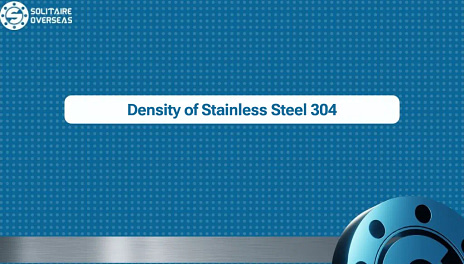Density of Stainless Steel 304 | SS 304 Density in kg/m3

Stainless steel 304, often referred to as 1.4301 or by its former name 18/8, stands as a pinnacle in the realm of stainless steel alloys. Beyond its versatile applications and nomenclature intricacies, understanding the density of this alloy delves into the very core of its material makeup.
Exploring Stainless Steel 304 and its Types:
Stainless steel 304 and its low-carbon counterpart, 304L (1.4307), embody a unique blend of chromium and nickel, with 18% and 8%, respectively. This austenitic marvel is prized for its deep-drawable nature, making it a staple in everyday items like sinks and saucepans. For heavy gauge components requiring superior weldability, the industry turns to the 304L variant.
Enter stainless steel 304H, a high-carbon variant tailored for high-temperature exploits. While 304 and 304L carve their niches in standard applications, 304H steps up to the plate when elevated temperatures come into play. These distinctions become crucial in various industries where performance under extreme conditions is paramount.
The density of Stainless steel 304 is 7,930 kg/m3 or 7.93 g/cm3, equivalent to 0.286 lb/in3. For those immersed in the intricacies of the International System of Units (SI), this means that one cubic meter of stainless steel 304 weighs 7,930 kg.
The Formula Behind the Density:
Density (ρ) is more than just a numerical value; it’s a relationship between mass (m) and volume (V). Expressed as ρ = m/V, this formula encapsulates the essence of density. Whether measured in grams per cubic centimeter (g/cm3), kilograms per cubic meter (kg/m3), or grams per cubic decimeter (kg/dm3), stainless steel 304’s density provides a lens through which its material essence comes to life.
| Stainless Steel | Density (g/cm3) | Density (kg/dm3) | Density (kg/m3) | Density (lb/in3) | Density (lb/ft3) |
|---|---|---|---|---|---|
| 304 | 7.93 | 7.93 | 7,930 | 0.286 | 495.05 |
Stainless Steel 304 Chemical Composition
| Element | % Present |
|---|---|
| Carbon (C) | 0.07 |
| Chromium (Cr) | 17.50 – 19.50 |
| Manganese (Mn) | 2.00 |
| Silicon (Si) | 1.00 |
| Phosphorous (P) | 0.045 |
| Sulphur (S) | 0.015b) |
| Nickel (Ni) | 8.00 – 10.50 |
| Nitrogen (N) | 0.10 |
| Iron (Fe) | Balance |
Stainless Steel 304 Mechanical properties
| Property | Value |
|---|---|
| Comprehensive Strength | 210 MPa |
| Proof Stress | 210 Min MPa |
| Tensile Strength | 520 – 720 MPa |
| Elongation | 45 Min% |
Stainless Steel 304 Physical Properties
| Property | Value |
|---|---|
| Density | 8,000 Kg/m3 |
| Melting Point | 1450 °C |
| Thermal Expansion | 17.2 x 10-6 /K |
| Modulus of Elasticity | 193 GPa |
| Thermal Conductivity | 16.2W/m.K |
| Electrical Resistivity | 0.072 x 10-6 Ω .m |
Stainless Steel 304 Corrosion Resistance
Despite its resilience, Stainless Steel 304 reveals a susceptibility to pitting and crevice corrosion when faced with environments rich in chlorides. This nuanced vulnerability prompts a closer examination, particularly in applications where chlorides are prevalent, such as marine or industrial settings.
The temperature threshold introduces another layer to Stainless Steel 304’s corrosion narrative. While it admirably adapts to varying temperatures, caution arises at levels exceeding 60°C. Under such conditions, the alloy may be prone to stress corrosion cracking, emphasizing the need for prudent consideration in applications subject to elevated temperatures.
Stainless Steel 304 Heat Resistance
Stainless Steel 304 stands resilient against oxidation, demonstrating excellence in intermittent service up to 870°C and continuous service up to 925°C. This thermal fortitude positions it as a reliable choice in environments subject to fluctuating heat.
Caution unfurls when considering continuous use between 425°C and 860°C. Under these conditions, Stainless Steel 304 is not the recommended choice due to potential challenges. In such scenarios, its counterpart, 304L, steps forward as the preferred option, offering resistance to carbide precipitation and enhancing long-term performance.
For applications demanding high strength within the temperature range of 500°C to 800°C, the spotlight shifts to grade 304H. This variant of Stainless Steel 304 not only navigates elevated temperatures with poise but also ensures robustness when strength is paramount.
What sets Stainless Steel 304 apart is its ability to retain aqueous corrosion resistance even at elevated temperatures. This distinctive trait further broadens its scope of applications, making it a reliable choice in environments where both heat and corrosion challenges are present.
304 Stainless steel Heat Treatment
To imbue Stainless Steel 304 with strength, one embarks on a journey of controlled heat. Elevating the material to a temperature range of 1010-1120°C forms the cornerstone of solution treatment or annealing. This deliberate elevation primes the alloy for transformation, setting the stage for enhanced mechanical properties.
The magic doesn’t end with the rise in temperature. It crescendos as the material is swiftly cooled. This rapid cooldown, a pivotal act in the thermal ballet, solidifies the structural changes initiated during the heating phase. The result is a Stainless Steel 304 endowed with improved toughness and resilience.
While traditional hardening eludes Stainless Steel 304, the pathway of solution treatment and annealing isn’t merely about hardness. It’s a tailored journey, sculpting properties to match the desired application. The alloy emerges not just stronger but with characteristics finely tuned for specific roles.
304 Stainless Steel Applications
- Saucepans
- Springs, screws, nuts & bolts
- Sinks & splash backs
- Architectural paneling
- Tubing
- Brewery, food, dairy and pharmaceutical production equipment
- Sanitary ware and troughs
Why do you need to know the density of stainless steel?
Understanding the density of stainless steel, particularly in the case of Stainless Steel 304, holds significant importance in various industrial processes. Here are a few key reasons why knowing the density is crucial:
- Weight Calculation in Metal Manufacturing:
- Manufacturers often need to calculate the weight of stainless steel before casting or molding processes. By knowing the density, they can determine the mass of the metal based on its volume, aiding in precise planning and resource utilization.
- Precision in Melting Processes:
- In metal melting processes, such as casting, the density of stainless steel is a critical parameter. It helps in accurately estimating the amount of metal required, ensuring the production of high-quality and consistent castings.
- Weight Determination for Various Products:
- The density of stainless steel is a key factor in calculating the weight of finished products. Whether it’s steel wire, steel plate, steel pipe, or section steel, knowing the density enables manufacturers to determine the weight of these products with precision.
- Material Selection and Cost Estimation:
- For engineers and designers, understanding the density of stainless steel aids in material selection for specific applications. It also plays a role in estimating material costs, as weight is often a critical factor in pricing.
- Quality Control:
- In industries where strict quality control is essential, knowing the density of stainless steel ensures that the specified amount of material is used in production, contributing to consistency and adherence to quality standards.
Conclusion:
In essence, the density of stainless steel, particularly Stainless Steel 304, is a fundamental parameter that influences various stages of the manufacturing process. From planning and production to quality control and cost estimation, this knowledge ensures efficiency, accuracy, and the overall success of diverse industrial applications. Stainless Steel 304’s versatility and reliability, coupled with a deep understanding of its properties, make it a cornerstone material in the world of metallurgy.
